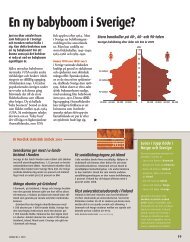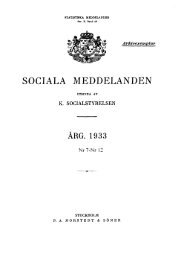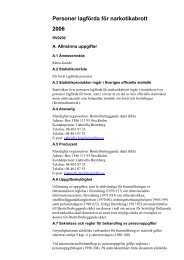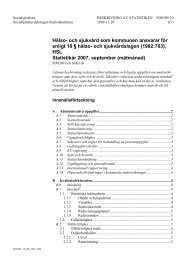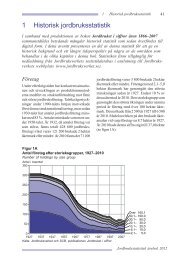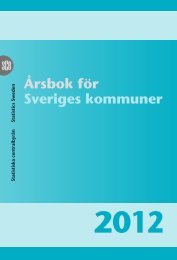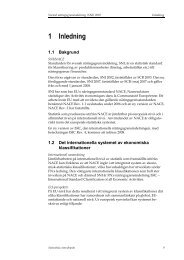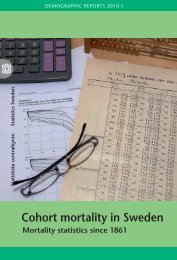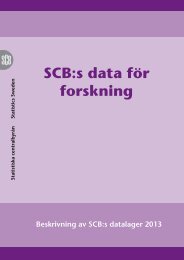Kvalitetsbegrepp och riktlinjer för kvalitets - Statistiska centralbyrån
Kvalitetsbegrepp och riktlinjer för kvalitets - Statistiska centralbyrån
Kvalitetsbegrepp och riktlinjer för kvalitets - Statistiska centralbyrån
You also want an ePaper? Increase the reach of your titles
YUMPU automatically turns print PDFs into web optimized ePapers that Google loves.
characteristics to be compared. This requirements is also important when statistics<br />
from different sources are to be combined.<br />
Statistics are made available to users by different dissemination forms, via different<br />
media (e.g. on paper, on diskettes and other electronic media) and through different<br />
channels (e.g. periodical reports by mail, year books, Reuter, Internet). Statistical<br />
information is presented in different ways, in tables, charts, text, etc.<br />
Some users want statistics other than those published regularly. Sometimes such<br />
statistics, although not published, are available by the producer, in other cases they<br />
can be created by special processing of the primary data. A further alternative,<br />
which is requested by many users, in particular researchers and investigators, is<br />
direct access to (de-identified) primary data, which allows the users to derive statistics<br />
and make analyses themselves according to their own specific interests.<br />
Users' confidence in statistics depends on their beliefs about errors, unintentional as<br />
well as intentional. Not even a very careful statistics producer can avoid some<br />
unintentional uncertainty in the statistics. It is a fact of life, however, that deliberately<br />
false, non-objective, statistics sometimes occur, which of course is a serious<br />
quality deficiency. However, the aspect objectivity is not included in the quality<br />
concept. It is more or less impossible to judge if statistics are objective or not, and<br />
producers of false statistics would not inform their users about it. As regards Sweden,<br />
the law 1992 : 889 states the following. "Official statistics shall be objective<br />
and generally available".<br />
As already said, "user" refers to existing as well as potential users. There will<br />
always be organisations and persons who consider that their needs are not met by<br />
the official statistics, either because the statistics are not produced at all or because<br />
available statistics is not accurate enough. Producers should be keen to take such<br />
requirements into account when evaluating and revising surveys.<br />
Quality concept for official statistics<br />
How a user delimits the portion of statistics, with which his/her quality opinion is<br />
concerned, depends on his/her specific subject matter problem and application<br />
interest. "The statistics" may consist of a single value, of all statistics from a particular<br />
survey or statistics from different surveys to be used together. It may also<br />
concern "flows" (over time) of statistics. It is of course so that the more the concerned<br />
portion of statistics encompasses, the more quality aspects does it have. The<br />
following quality concept is meant to be applicable whatever the statistics extent<br />
may be, but for small "statistics packages" some of the quality components may be<br />
irrelevant.<br />
There is no self-evident division of the total collection of quality aspects for statistics<br />
into main aspects and sub-aspects. The quality concept which is presented<br />
below has the following five main components. (1) Contents, which concerns the<br />
target characteristics. (2) Accuracy, concerning sources of inaccuracy and their<br />
effects on the statistics. (3) Timeliness, concerning time aspects of relevance for<br />
how well the statistics describe the "now" situation. (4) Coherence especially comparability,<br />
concerning possibilities to make comparisons, over time and between<br />
groups, and to use the statistics jointly with statistics from other sources. (5) Availability<br />
and clarity, concerning physical availability of the statistics and their understandability.<br />
It has been emphasised earlier that the quality concept is user oriented. As a consequence,<br />
it should as far as possible be formulated from the users' point of view (not<br />
the producers'). There are exceptions from this principle, however, particularly for<br />
the quality component "accuracy". For the user "overall accuracy" is of chief interest,<br />
while its decomposition into different uncertainty sources, as is made in the<br />
quality is of a technical, producer oriented nature. The reason for specifying "nar-<br />
33




